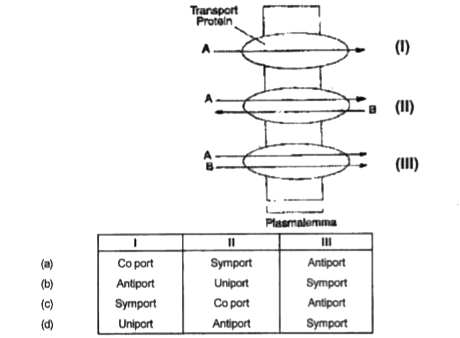Select the neuroendocrine process mechanism from the mentioned reproductive events.
I. Parturition
II. Lactation
III. Menstrual cycle
I and II
II and III
Only I
I,II and III
The correct Answer is:D
To solve the question regarding the neuroendocrine process mechanism involved in the reproductive events of Parturition, Lactation, and the Menstrual Cycle, we will analyze each event step by step.
Step 1: Understanding Parturition
- Explanation: Parturition, or childbirth, is initiated by a complex neuroendocrine mechanism. The signal for parturition originates from the fully developed fetus, which triggers the release of hormones from the placenta. This results in the production of oxytocin from the pituitary gland, leading to stronger uterine contractions that facilitate childbirth.
- Conclusion: Parturition is a neuroendocrine process.
Hint: Look for signals from the fetus and the role of hormones in initiating childbirth.
Step 2: Understanding Lactation
- Explanation: Lactation, the production of milk, occurs after parturition and involves neuroendocrine processes as well. After childbirth, several hormones, including estrogen, progesterone, and human placental lactogen, are released, which stimulate milk production in the breasts.
- Conclusion: Lactation is also a neuroendocrine process.
Hint: Consider the hormonal changes that occur after childbirth and their role in milk production.
Step 3: Understanding the Menstrual Cycle
- Explanation: The menstrual cycle is a regular series of changes that occur in the female reproductive system, driven by hormonal regulation. The cycle involves the production of oocytes and is regulated by hormones from the hypothalamus, pituitary gland, and ovaries, indicating a neuroendocrine relationship.
- Conclusion: The menstrual cycle is a neuroendocrine process.
Hint: Focus on the hormonal regulation and its impact on the reproductive system.
Final Conclusion
After analyzing all three reproductive events, we conclude that all of them—Parturition, Lactation, and the Menstrual Cycle—are neuroendocrine processes. Therefore, the correct answer is that all three options are neuroendocrine processes.
Final Answer: All three events (I, II, and III) are neuroendocrine processes.
- Explanation: Parturition, or childbirth, is initiated by a complex neuroendocrine mechanism. The signal for parturition originates from the fully developed fetus, which triggers the release of hormones from the placenta. This results in the production of oxytocin from the pituitary gland, leading to stronger uterine contractions that facilitate childbirth.
- Conclusion: Parturition is a neuroendocrine process.
- Explanation: Lactation, the production of milk, occurs after parturition and involves neuroendocrine processes as well. After childbirth, several hormones, including estrogen, progesterone, and human placental lactogen, are released, which stimulate milk production in the breasts.
- Conclusion: Lactation is also a neuroendocrine process.
- Explanation: The menstrual cycle is a regular series of changes that occur in the female reproductive system, driven by hormonal regulation. The cycle involves the production of oocytes and is regulated by hormones from the hypothalamus, pituitary gland, and ovaries, indicating a neuroendocrine relationship.
- Conclusion: The menstrual cycle is a neuroendocrine process.
After analyzing all three reproductive events, we conclude that all of them—Parturition, Lactation, and the Menstrual Cycle—are neuroendocrine processes. Therefore, the correct answer is that all three options are neuroendocrine processes.
Topper's Solved these Questions
Similar Questions
Read following statements (a-d) and choose the option with only correct statements.
a. Parturition occurs due to a complex neuroendocrine mechanism at the end of gestation period.
b. The signals for parturition originate from fully developed foetus and placenta which induces mild uterine contraction.
c. Foetal ejection reflex triggers release of oxytocin from foetal pituitary.
d. Oxytocin reduces uterine contraction under positive feedback control and causes expulsion of placenta followed by foetus known as parturition.
a and b
b and c
c and d
a and d
View SolutionSketch and label diagrams.
i. Human male reproductive system ii. Human female reproductive system
iii. Flower with its sexual reproductive system iv. Menstrual cycle
View Solution
Knowledge Check
Read the following sentences about human reproduction:
A. The process of childbirth or parturition is induced by a complex neuroendocrine mechanism involving oxytocin.
B. The reproductive cycle of all primate mammals is called the menstrual cycle.
C. Most of the major organ systems of the foetus including genital organ systems of the foetus including genital organs are developed by the end of 24 weeks.
D . The second meiotic division of secondary oocyte is unequal and results in the formation of an ovum and a second polar body.
How many from the above is/ are incorrect ?AfourBThreeCTwoDOneIdentify the correct sequence of events in the viral replication process.
I. Eclipse , II. Maturation
III. Adsorption, IV. Assembly V. Pentration , VI. LysisAI, II, III , IV, V, VIBII, I, III, IV, V, VICIII, V, I, II, IV, VIDIII, V, VI, IV, II, IWhich of these events are parts of mitosis ?
I. Interphase
II. Anaphase
III. CytokinesisAI , II and IIIBI and III onlyCI onlyDII only
Sketch and label diagrams.
i. Human male reproductive system ii. Human female reproductive system
iii. Flower with its sexual reproductive system iv. Menstrual cycle
View SolutionIdentify the process occuring in I, II and III -

View SolutionFSH and LH get their names from events of the female reproductive cycle, but they also function in males. How are their function in females and males similar?
View SolutionWhich of the following statement about natural selection are correct ?
Tends to increases the characters that enhance survival and reproduction
(ii) Causes adaptation
(iii) Acts on an organism phenotype
(iv) Was considered as mechanism of evolution by Darwin
View SolutionArrange the following events in chronological order and select the correct answer from the codes given below:
I. Poona Pact
II. Gandhi-Irwin Agreement
III. Cripps Mission
IV. Civil Disobedience Movement
View Solution
